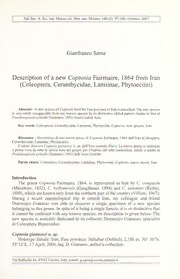
Description of a new Coptosia Fairmaire, 1864 from Iran (Coleoptera, Cerambycidae, Lamiinae, Phytoeciini) PDF
Preview Description of a new Coptosia Fairmaire, 1864 from Iran (Coleoptera, Cerambycidae, Lamiinae, Phytoeciini)
Atti Soc. it. Sci. nat. Museo civ. Stor. nat. Milano, 148 (I): 97-100, Gennaio 2007 Gianfranco Sama Description of a new Coptosia Fairmaire, 1864 from Iran (Coleoptera, Cerambycidae, Lamiinae, Phytoeciini) Abstract - A new species of Coptosia from thè Fars province in Iran is described. The new species is very easily recognizable from any known species by its distinctive elytral pattern similar to that of Pseudocoptosia eylandti (Semenov, 1891) from Central Asia. Key words: Coleoptera, Cerambycidae, Lamiinae, Phytoeciini, Coptosia, new species, Iran. Riassunto - Descrizione di una nuova specie di Coptosia Fairmaire, 1864 dell’Iran (Coleoptera, Cerambycidae, Lamiinae, Phytoeciini). L’autore descrive Coptosia gianassoi n. sp. dell'Iran centrale (Fars). La nuova specie si distingue a prima vista da tutte le specie note del genere per l’habitus del tutto particolare, simile a quello di Pseudocoptosia eylandti (Semenov, 1891) dell’Asia Centrale. Parole chiave: Coleoptera, Cerambycidae, Lamiinae, Phytoeciini, Coptosia, nuova specie, Iran. Introduction The genus Coptosia Fairmaire, 1864, is represented in Iran by C. compacta (Ménétries, 1832), C. bythiniensis (Ganglbauer, 1884) and C. antoniae (Reitter, 1889), which are known only from thè northern part of thè country (Villiers, 1967). During a recent entomological trip in centrai Iran, my colleague and friend Domenico Gianasso was able to discover a single specimen of a new species belonging to this genus. In spite of it being a single female, it is so distinctive that it cannot be confused with any known species; its description is given below. The new species is amicably dedicated to its collector, Domenico Gianasso, specialist in Coleoptera Buprestidae. Coptosia gianassoi n. sp. Holotype female: Iran, Fars province: Safsahar (Dehbid), 2,188 m, 30° 30’N, 53°12’E, 17 Aprii, 2006, leg. D. Gianasso, author’s collection. Via Raffaello 84, 47023 Cesena, Italy, e-mail: [email protected] 98 GIANFRANCO SAMA Fig. 1 - Coptosia gianassoi n. sp., Holotype (Olotipo) 9 DESCRIPTION OF A NEW COPTOSIA FAJRMAIRE, 1864 FROM IRAN 99 (COLEOPTERA, CERAMBYCIDAE, LAMIINAE. PHYTOECIINI) Description of thè holotype temale (Fig. 1) Length: 12.5 mm (pygidium included). Integument black, dorsal surface clothed with whitish and golden-brown pubescence forming a distinctive pattern. Head densely clothed with grey and brown intermixed pubescence and a patch of whitish pubescence extending backwards from thè frons to thè vertex. Pronotum densely clothed with appressed brown pubescence and with three longitudini stripes of white pubescence. Scutellum densely clothed with white appressed pubescence. Elytra clothed with appressed pubescence in rather well delimited lon¬ gitudini vittae of different width: each elytron has one suturai and one humeral stripe of white pubescence, one dorsal and one lateral stripe of brown pubescence; ventral side of thè body moderately densely clothed with greyish pubescence and with sparse erect golden hairs; abdomen with numerous round, glabrous areas. Head with front convex, antennal tubercles not protruding, widely separated; eyes finely facetted, very deeply emarginate; mandibles short, unicuspidate on tips; palpi subequal, last segment of maxillary palpi moderately short, longer than thè two preceding together, longer than thè preceding one; last segment of labial palpi about as long as thè preceding one. Pronotum moderately transverse, slightly con¬ vex on thè disc, almost parallel sided. Elytra strongly convex, humeri distinct, apices separately rounded. Prosternai process narrow, gradually curved between coxae, dilated apically; front coxae slightly angulate laterally, closed posteriorly; mesosternal process subtriangular, wider than thè prosternai; intermediate coxal cavities open laterally to thè epimera; metastemum with a short preapical oblique impression at each side of thè middle; metepisterna wide, tapering posteriorly; last abdominal stemite with a thin longitudinal incision at base and shallowly trans- versely impressed before thè apex. Antennae short, not extending beyond thè mid¬ dle of elytra, with segments rather robust; lst segment 1.73x longer than each 3rd, 4th and 5* which are similar in length; segments 6th to 11* clothed with dark brown pubescence, distinctly annulated with cinereous pubescence at base. Legs short, with tarsal segments short; thè first segment of hind tarsi not longer than thè two following united; thè second segment transverse, about as wide as long, thè last segment slightly shorter than thè preceding one, cleft almost to its base; tarsal claws appendiculate, thè inner tooth very short, not longer than thè half of thè outer tooth. Discussion The new species is very easily recognizable from any known species of Coptosia; C. compacta and C. bithyniensis differ from thè new species by differ¬ ent elytral pattern, pronotum conspicuously expanded and dilated laterally, thè whole body with numerous long erect setae, antennae longer and with segments not annulated. C. antoniae differs from C. gianassoi n. sp. for its totally different coloration, with pronotum and elytra uniformly black, without longitudinal stripes, and clothed with fine gray pubescence. The elytral pattern of C. gianassoi n. sp. resembles, in fact, some species of Pseudocoptosia Pie, 1943, such as P. eylandti Semenov, 1891 from Central Asia; this latter differs from thè new species by its pronotum more convex and distinctly dilated laterally, antennae conspicuously 100 GIANFRANCO SAMA longer, extending, in female, to thè apical third of elytra, with segments slender and not annidateci, thè lst one only 1.16 times longer than 3rd, this latter 1.28 times longer than 4th; elytra with short erect setae on basai half, legs with tarsi longer and more slender. Biology All known species of Coptosia develop in roots of Boraginaceae; according to its collector, thè single specimen of thè new species was found under basai leaves of a plant of Eryngium sp. I do not know if Eryngium is ready thè host plant of thè new species or if thè female used this plant as a casual shelter; further researches devoted to find more specimens have been totally fmitless. References Villiers A., 1967 - Contribution à la faune de l’Iran. I. Coléoptères Cerambycidae. Ann. Soc. entomol. France (N.S.), 3 (2): 327 - 379. Ricevuto: 16 maggio 2006 Approvato: 31 maggio 2006
